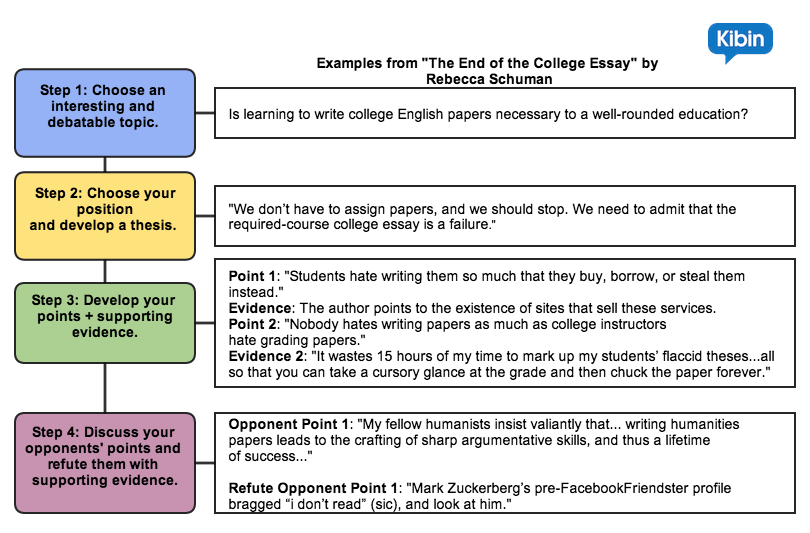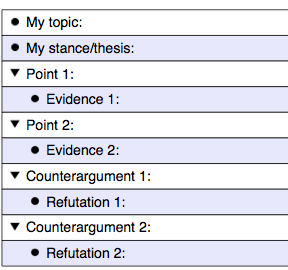When you get into debates with friends or family members, do you tend to win or lose? The art of arguing is closely related to your ability to harness compelling facts, statistics, and concepts that support your viewpoint on a topic. When you lose an argument, chances are you only used opinion to support your position.
Being able to argue in a logical and reasonable way is a great life skill. It will help you to stand up for what you think is right and to get others to pay attention to your reasoning. In this blog post, I’ll teach you the secrets of a strong argumentative essay.
Important Elements of an Argumentative Essay
The goal of an argumentative essay is to convince others that your opinion is valid. Usually, an argumentative essay addresses readers who hold an opposing viewpoint on a particular issue. For example, you might argue the virtues of solar power to a group of city leaders invested in coal and oil.
There are four important elements to consider when constructing an argumentative essay.
#1 Your topic must be debatable.
When selecting an issue to argue, you need to choose a topic that has more than one side.
For example, there is no way you can argue on the topic of whether humans walk on two legs because it’s a known fact with no attached debate.
 However, you could argue for days about contentious topics like GMOs, gun control, and even fast food. For example, should the government regulate the sale of sugary beverages? That’s certainly a question up for debate.
However, you could argue for days about contentious topics like GMOs, gun control, and even fast food. For example, should the government regulate the sale of sugary beverages? That’s certainly a question up for debate.
#2 You must take a strong stance.
You can’t possibly argue if you don’t take a stance and write a compelling thesis.
Imagine reading an argument about the regulation of sugary beverages that says something like, “I enjoy drinking Pepsi, so I’d like to be able to purchase it as I please, but the government should regulate it because it’s making me gain weight.”
All this does is confuse the reader. Is the author for or against the regulation of sugary beverages?
Take a stance and stick with it. A strong stance might be, “The government should regulate the purchase of sugary beverages because these drinks lead to a higher prevalence of diabetes.”
In this second example, it’s obvious which side of the argument the author is taking.
#3 Your argument must be supportable.
A good argument requires the use of logic and irrefutable evidence. You must be able to back up your statements with facts, statistics, examples, and informed opinions from experts. In the argument for regulating sugary beverages, the author might write something like, “A study by Imperial College London found that drinking just one 12-ounce can of soda per day leads to a 22% increase in a person’s chances of developing diabetes.”
An argumentative essay does not include unsubstantiated opinions. Writing “I think sugary drinks should be regulated because they are unhealthy” is not a valid argument…unless you support it with evidence.
#4 You must refute alternate positions.
The final element of a strong argumentative essay is refuting alternate positions. By addressing opposing positions, you make your argument stronger. It’s best to try to address the most common opposing beliefs.
For example, an opponent might say, “By drinking sugary drinks, I’m only hurting myself, so it’s not the government’s place to ban them.”
To refute this argument, the author might write something like, “The American Diabetes Association reports that the cost of diabetes has risen 41% in five short years, from $174 billion in 2007 to $245 billion in 2012. It’s a social problem that decreases productivity in the workforce and costs taxpayers money.”
By refuting alternate opinions, you make your opponents question their own arguments, which is a powerful tactic indeed.
A Real Argumentative Essay Dissected
To help you wrap your mind around the argumentative essay, I’ll dissect an example from a real argument that I found online.
In a 2013 Slate article, “The End of the College Essay,” author Rebecca Schuman argues against the practice of college teachers assigning essays to students. She follows the four elements of an argumentative essay as I described above. Here’s a table that breaks it down for you:
 Now, as an English buff and a fierce believer in the importance of being able to communicate well through writing, I’m definitely against Schuman’s argument. However, she does such an amazing job writing her argumentative essay that I have to admit she makes a compelling point.
Now, as an English buff and a fierce believer in the importance of being able to communicate well through writing, I’m definitely against Schuman’s argument. However, she does such an amazing job writing her argumentative essay that I have to admit she makes a compelling point.
And that, my friends, is the mark of a successful argument!
Final Thoughts on the Argumentative Essay
An argumentative essay doesn’t always have to follow a traditional 5-paragraph outline structure. As long as it contains all four of the elements we discussed, you can write a compelling and thorough argument.
Next time you need to write an argumentative essay, simply create an outline that covers the four steps I discussed. It might look something like this:
Need more help? Read How to Create a Powerful Argumentative Essay Outline.
How many points and counterarguments you include will depend on several factors, including your teacher’s requirements, if applicable, and the number of excellent points you can find to support your position in the first place. When in doubt, refer to the requirements of your assignment.
Also, be sure to include a good hook sentence to start off your paper. You’ll definitely lose the argument if no one wants to read your essay.
Finally, an argumentative essay that is polished and edited will be better received than one that isn’t.
Don’t go into your next argumentative essay empty-handed. Instead, gather the supportive evidence you need to argue and win. Good luck!
* Cover Image Credit: Northern Mockingbird juveniles at a bird bath in Austin, Texas. Original photo by Chiltepinster. (Creative Commons license)


